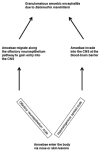Balamuthia mandrillaris: Morphology, biology, and virulence
- PMID: 25709948
- PMCID: PMC4326988
- DOI: 10.4103/2229-5070.149888
Balamuthia mandrillaris: Morphology, biology, and virulence
Abstract
Balamuthia mandrillaris is a protist pathogen that can cause encephalitis with a fatality rate of >95%. This is due to our incomplete understanding of the pathogenesis and pathophysiology of B. mandrillaris encephalitis. B. mandrillaris has two stages in its life cycle, an active trophozoite stage during which it divides mitotically. However, under unfavorable conditions, the trophozoite transforms into a dormant cyst stage. A major concern during the course of therapy is that B. mandrillaris can transform into cysts. Cysts are highly resistant to physical and chemical conditions and present a problem in successful antimicrobial chemotherapy. Several lines of evidence suggest that B. mandrillaris encephalitis develops as a result of hematogenous spread, but it is unclear how circulating amoebae enter the central nervous system and cause inflammation, blood-brain barrier disruption, and neuronal injury. Recent studies have identified several parasite-host determinants for B. mandrillaris translocation of the blood-brain barrier, and host inflammatory markers that may be associated with neuronal injury. These determinants may provide important targets for the prevention and treatment of this devastating infection. Here, we present a brief overview of the current understanding of the morphology, biology, pathogenesis, and pathophysiology of B. mandrillaris encephalitis.
Keywords: Balamuthia mandrillaris; biology; encephalitis; morphology; pathogenesis; virulence.
Conflict of interest statement
Figures




References
-
- Visvesvara GS, Stehr-Green JK. Epidemiology of free-living ameba infections. J Protozool. 1990;37:S25–S33. - PubMed
-
- Amaral Zettler LA, Nerad TA, O'Kelly CJ, Peglar MT, Gillevet PM, Silberman JD. et al.A molecular reassessment of the leptomyxid amoebae. Protist. 2000;151:275–82. - PubMed
-
- Booton GC, Carmichael JR, Vivesvara GS, Byers TJ, Fuerst PA. Genotyping of Balamuthia mandrillaris based on nuclear 18S and mitochondrial 16S rRNA genes. Am J Trop Med Hyg. 2003;68:65–9. - PubMed
-
- Lorenzo-Morales J, Cabello-Vílchez AM, Martín-Navarro CM, Martínez-Carretero E, Piñero JE, Valladares B. Is Balamuthia mandrillaris a public health concern worldwide. Trends Parasitol. 2013;29:483–8. - PubMed
LinkOut - more resources
Full Text Sources
Other Literature Sources

